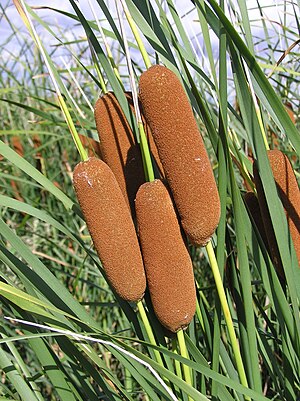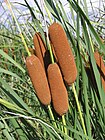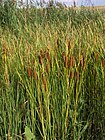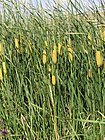Note: This is a project under development. The articles on this wiki are just being initiated and broadly incomplete. You can Help creating new pages.
Difference between revisions of "Typha laxmanni"
(Created page with "{{stub}} ==Uses== {{Uses|}}, {{Uses|}}, {{Uses|}}, {{Uses|}}, {{Uses|}}, {{Uses|}}, {{Uses|}}, {{Uses|}}, {{Uses|}}, {{Uses|}}, {{Uses|}}.<ref name="Uses"/> ==Parts Used== {{...") |
|||
| Line 1: | Line 1: | ||
| − | + | [[File:Typha laxmannii (fruit) 1.jpg|thumb|right|''Typha laxmanni']] | |
| + | '''Typha laxmannii''' is a herbaceous perennial plant growing from a vigorous, rhizomatous rootstock. The plant forms a large, dense clump of erect, unbranched stems 80 - 150cm tall. The plant is harvested from the wild for local use as a food, medicine and source of materials. This species is widespread with stable populations and does not face any major threats. | ||
==Uses== | ==Uses== | ||
| − | {{Uses|}}, {{Uses|}}, {{Uses|}}, {{Uses|}}, {{Uses|}}, {{Uses| | + | {{Uses|Kidney stones}}, {{Uses|Haemorrhage}}, {{Uses|Painful menstruation}}, {{Uses|Abnormal uterine bleeding}}, {{Uses|Post-partum pains}}, {{Uses|Abscesses}}.<ref name="Uses"/> |
==Parts Used== | ==Parts Used== | ||
| − | {{Parts Used|}}, {{Parts Used| | + | {{Parts Used|Young shoots}}, {{Parts Used|Rhizomes}}. |
==Chemical Composition== | ==Chemical Composition== | ||
| Line 16: | Line 17: | ||
===Dravya=== | ===Dravya=== | ||
===Rasa=== | ===Rasa=== | ||
| − | |||
===Guna=== | ===Guna=== | ||
| Line 29: | Line 29: | ||
==Habit== | ==Habit== | ||
| − | {{Habit|}} | + | {{Habit|Perennial}} |
==Identification== | ==Identification== | ||
| Line 48: | Line 48: | ||
==Mode of Propagation== | ==Mode of Propagation== | ||
| − | {{Propagation|}} | + | {{Propagation|Seeds}}, {{Propagation|Division in spring}}. |
==How to plant/cultivate== | ==How to plant/cultivate== | ||
| − | <ref name="How to plant/cultivate"/> | + | Grow in a rich soil in boggy pond margins or shallow water to 15cm deep. Succeeds in sun or part shade.<ref name="How to plant/cultivate"/> |
==Commonly seen growing in areas== | ==Commonly seen growing in areas== | ||
| − | {{Commonly seen|}}, {{Commonly seen|}}, {{Commonly seen|}}, {{Commonly seen| | + | {{Commonly seen|Rivers}}, {{Commonly seen|Ditches}}, {{Commonly seen|Wet places}}, {{Commonly seen|Wet marshy places}}. |
==Photo Gallery== | ==Photo Gallery== | ||
<gallery class="left" caption="" widths="140px" heights="140px"> | <gallery class="left" caption="" widths="140px" heights="140px"> | ||
| − | + | Typha laxmannii (fruit) 1.jpg | |
| + | Typha laxmannii (habitat).jpg | ||
| + | Typha laxmannii (habitus) 1.jpg | ||
| + | Typha laxmannii (short).jpg | ||
| + | Typha laxmannii (yellow) 1.jpg | ||
| + | Typha laxmannii (yellow) 2.jpg | ||
| + | Typha laxmannii (yellow) 3.jpg | ||
</gallery> | </gallery> | ||
| Line 64: | Line 70: | ||
<references> | <references> | ||
| − | <ref name="chemical composition">[ | + | <ref name="chemical composition">[Chemical constituents]</ref> |
| − | <ref name="Leaf">[ | + | <ref name="Leaf">[Morphology]</ref> |
| − | <ref name="How to plant/cultivate">[ | + | <ref name="How to plant/cultivate">[http://temperate.theferns.info/plant/Typha+laxmannii Cultivation]</ref> |
<ref name="Uses">Indian Medicinal Plants by C.P.Khare</ref> | <ref name="Uses">Indian Medicinal Plants by C.P.Khare</ref> | ||
</references> | </references> | ||
==External Links== | ==External Links== | ||
| − | * [ ] | + | * [https://pfaf.org/user/Plant.aspx?LatinName=Typha+minima Typha laxmanni on pfaf.org] |
| − | + | ||
| − | |||
[[Category:Herbs]] | [[Category:Herbs]] | ||
Latest revision as of 15:31, 28 August 2020
Typha laxmannii is a herbaceous perennial plant growing from a vigorous, rhizomatous rootstock. The plant forms a large, dense clump of erect, unbranched stems 80 - 150cm tall. The plant is harvested from the wild for local use as a food, medicine and source of materials. This species is widespread with stable populations and does not face any major threats.
Contents
- 1 Uses
- 2 Parts Used
- 3 Chemical Composition
- 4 Common names
- 5 Properties
- 6 Habit
- 7 Identification
- 8 List of Ayurvedic medicine in which the herb is used
- 9 Where to get the saplings
- 10 Mode of Propagation
- 11 How to plant/cultivate
- 12 Commonly seen growing in areas
- 13 Photo Gallery
- 14 References
- 15 External Links
Uses
Kidney stones, Haemorrhage, Painful menstruation, Abnormal uterine bleeding, Post-partum pains, Abscesses.[1]
Parts Used
Chemical Composition
Common names
| Language | Common name |
|---|---|
| Kannada | |
| Hindi | |
| Malayalam | |
| Tamil | |
| Telugu | |
| Marathi | |
| Gujarathi | |
| Punjabi | |
| Kashmiri | |
| Sanskrit | |
| English |
Properties
Reference: Dravya - Substance, Rasa - Taste, Guna - Qualities, Veerya - Potency, Vipaka - Post-digesion effect, Karma - Pharmacological activity, Prabhava - Therepeutics.
Dravya
Rasa
Guna
Veerya
Vipaka
Karma
Prabhava
Habit
Identification
Leaf
| Kind | Shape | Feature |
|---|---|---|
Flower
| Type | Size | Color and composition | Stamen | More information |
|---|---|---|---|---|
| {{{5}}} |
Fruit
| Type | Size | Mass | Appearance | Seeds | More information |
|---|---|---|---|---|---|
Other features
List of Ayurvedic medicine in which the herb is used
Where to get the saplings
Mode of Propagation
How to plant/cultivate
Grow in a rich soil in boggy pond margins or shallow water to 15cm deep. Succeeds in sun or part shade.[4]
Commonly seen growing in areas
Rivers, Ditches, Wet places, Wet marshy places.
Photo Gallery
References
- ↑ Indian Medicinal Plants by C.P.Khare
- ↑ [Chemical constituents]
- ↑ [Morphology]
- ↑ Cultivation
External Links
- Ayurvedic Herbs known to be helpful to treat Kidney stones
- Ayurvedic Herbs known to be helpful to treat Haemorrhage
- Ayurvedic Herbs known to be helpful to treat Painful menstruation
- Ayurvedic Herbs known to be helpful to treat Abnormal uterine bleeding
- Ayurvedic Herbs known to be helpful to treat Post-partum pains
- Ayurvedic Herbs known to be helpful to treat Abscesses
- Herbs with Young shoots used in medicine
- Herbs with Rhizomes used in medicine
- Habit - Perennial
- Index of Plants which can be propagated by Seeds
- Index of Plants which can be propagated by Division in spring
- Herbs that are commonly seen in the region of Rivers
- Herbs that are commonly seen in the region of Ditches
- Herbs that are commonly seen in the region of Wet places
- Herbs that are commonly seen in the region of Wet marshy places
- Herbs







